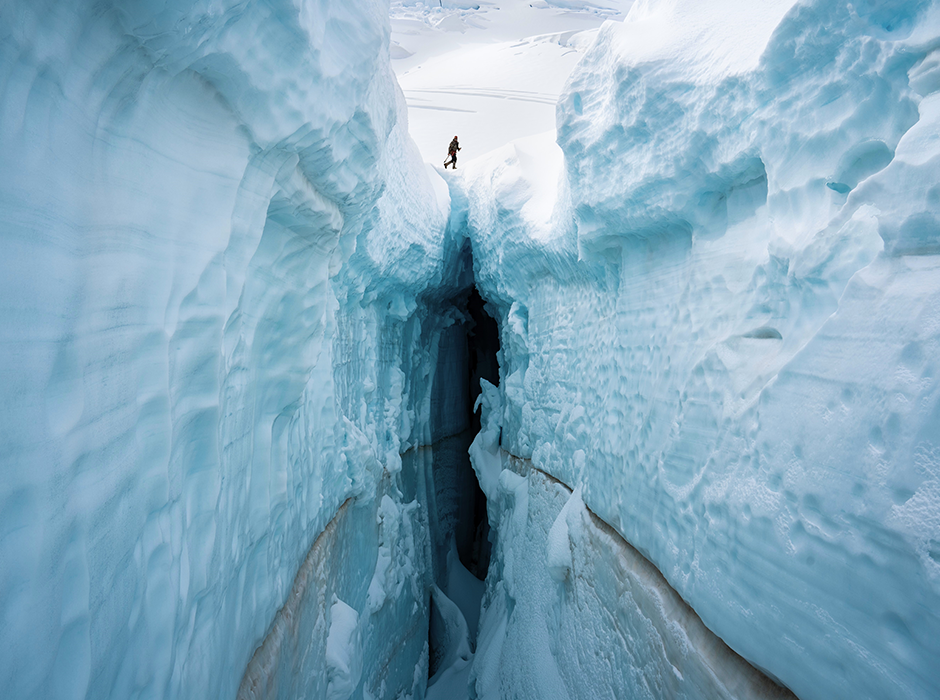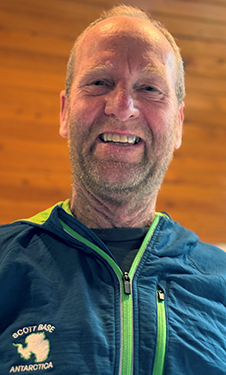
Shear zones can be dangerous places says, Professor David Prior. Studying the ice at accessible locations, like the Haupapa Tasman Glacier, help with understanding shear margins and their impact on ice flow.
Research to enhance ice sheet modelling aimed at predicting future sea level rise has been given a boost thanks to seed funding from the Matariki Network of Universities (MNU).
Professor David Prior, from Otago’s Department of Geology, will lead the research into the role of shear margins in rapid ice sheet acceleration, in collaboration with Matariki Network partners University of Tübingen and Durham University. The project, one of five awarded funding, received a grant of about $47,000.
Shear margins, where there is transition from fast-flow to near-stagnant ice or rock, are a significant control on the rate of flow for glaciers and ice streams. Fast ice flow feeds large floating ice shelves while shear zones dissect ice shelves and may influence their break-up, affecting sea level rise.

Project lead Professor David Prior has researched ice in Antarctica and the Haupapa Tasman glacier.
“A better understanding of the shear zones at the margins of fast ice flow is required to understand how ice responds to climate change,” David says.
“It is one of the more fundamental processes that feeds into the sea level rise equation.”
The project focusses on the ice sheets that are most critical for controlling how fast ice moves from land to sea, like in Antarctica and Greenland, he says.
It will also help address a gap in the data, with most of the current models lacking “a fair representation of the ice controlling the rate of flow”.
In alignment with the MNU’s principles of commitment to transnational dialogue and fostering research collaboration, part of the funding will be used to bring together researchers with different perspectives and ways of working with ice in the hope of coming up with a common set of ideas for the best way to understand what is going at the shear margins.
The University of Tübingen teams brings expertise of analysing geophysical and satellite ice sheet data, while the Durham University researchers have insight into shear margins in large scale modelling and the impact it has on the material under the ice, David says.
However, studying the ice in Antarctica and Greenland comes with its own “field and logistical challenges” meaning that of the many thousands of shear margins in Antarctica, only two have been worked on.
“Part of the reason is how dangerous and remote they are. Because they have high shearing rates, they tend to get big crevasse systems, making the logistics of getting there and working there very difficult.”
A work around is to use accessible places, like the Haupapa Tasman Glacier, to study shear margins and develop hypotheses that can then be extended to the ice on the polar margin, David says.
Another aspect the funding helps with is publicising the work multiple groups are undertaking on shear margins.
While the Matariki funding brings a subset of people together, the project team is hopeful it will act as a springboard to showcase their work to a wider group of people.
“There are some in the ice modelling community, particularly those working on large scale models, that do not get involved in the complexities of research data incorporated in the models. Publicising our work highlights data they should be considering and will hopefully bring them into the discussion.”
It was accepted sea level will rise, David says.
“What we don’t have is good, robust models to predict the rate at which it will rise. We need to learn more about the fundamentals of ice flow and its impact on sea level rise so we can support governments at all levels to make plans for the future.”
David is currently working on bringing the research collaborators to Aotearoa later this year to study the shear margins at the Haupapa Tasman Glacier.
“We hope this collaborative effort will up the understanding in our different approaches and we end up with globally much better data sets. The Matariki seed funding allows us to move forward in making that happen.”
~ Kōrero by Sandra French, Adviser, Internal Communications.